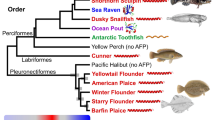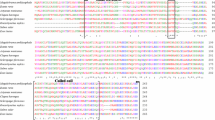Abstract
Type III antifreeze proteins (AFP III) in the Antarctic eelpout Lycodichthys dearborni contain at least two size variants—a 7-kDa protein family and a specific 14-kDa isoform composed of two 7-kDa domains linked in tandem. We report the characterization of a two-domain AFP III gene from L. dearborni, and propose that the two-domain AFP III gene arose from a single-domain AFP III gene through duplication and degeneration. AT-rich regions played an important role in the degeneration of the duplicated AFP III gene that resulted in the concatenation of two originally separated 7-kDa AFP-coding exons into a single gene. We also identified a pseudo-AFP III gene interrupted at an AT-rich coding region, supporting AT-rich regions as hotspots for DNA recombination in AFP III gene evolution. Interestingly, study of AFP III genes in the related Antarctic eelpout Pachycara brachycephalum showed absence of two- and multi-domain AFP III genes, indicating that modes of AFP III gene family evolution are specific within species.




Similar content being viewed by others
References
Chakrabartty A, Hew CL, Shears M (1988) Primary structures of the alanine-rich antifreeze polypeptides from grubby sculpin (Myoxocephalus aenaeus). Can J Zool 66:6
Cheng CH, DeVries AL (1989) Structures of antifreeze peptides from the antarctic eel pout, Austrolycicthys brachycephalus. Biochim Biophys Acta 997:55–64
Chen L, DeVries AL, Cheng CH (1997) Evolution of antifreeze glycoprotein gene from a trypsinogen gene in Antarctic notothenioid fish. Proc Natl Acad Sci USA 94:3811–3816
Cheng CH, Cziko PA, Evans CW (2006) Nonhepatic origin of notothenioid antifreeze reveals pancreatic synthesis as common mechanism in polar fish freezing avoidance. Proc Natl Acad Sci USA 103:10491–10496
Davies PL, Sykes BD (1997) Antifreeze proteins. Curr Opin Struct Biol 7:828–834
Deng G, Andrews DW, Laursen RA (1997) Amino acid sequence of a new type of antifreeze protein, from the longhorn sculpin Myoxocephalus octodecimspinosis. FEBS Lett 402:17–20
DeVries AL (1982) Biological antifreeze agents in cold water fishes. Comp Biochem Physiol 73A:14
DeVries AL, Cheng C-HC (1992) The role of antifreeze glycopeptides and peptides in the survival of cold water fishes. Springer, Berlin
DeVries AL, Lin Y (1977) Structure of a peptide antifreeze and mechanism of adsorption to ice. Biochim Biophys Acta 495:388–392
Edelmann L, Spiteri E, Koren K, Pulijaal V, Bialer MG, Shanske A, Goldberg R, Morrow BE (2001) AT-rich palindromes mediate the constitutional t(11;22) translocation. Am J Hum Genet 68:1–13
Ewart KV, Fletcher GL (1993) Herring antifreeze protein: primary structure and evidence for a C-type lectin evolutionary origin. Mol Mar Biol Biotechnol 2:20–27
Fletcher GL, Hew CL, Davies PL (2001) Antifreeze proteins of teleost fishes. Annu Rev Physiol 63:359–390
Hayes PH, Scott GK, Ng NF, Hew CL, Davies PL (1989) Cystine-rich type II antifreeze protein precursor is initiated from the third AUG codon of its mRNA. J Biol Chem 264:18761–18767
Hew CL, Wang NC, Joshi S, Fletcher GL, Scott GK, Hayes PH, Buettner B, Davies PL (1988) Multiple genes provide the basis for antifreeze protein diversity and dosage in the ocean pout, Macrozoarces americanus. J Biol Chem 263:12049–12055
Kurahashi H, Inagaki H, Hosoba E, Kato T, Ohye T, Kogo H, Emanuel BS (2007) Molecular cloning of a translocation breakpoint hotspot in 22q11. Genome Res 17:461–469
Miura K, Ohgiya S, Hoshino T, Nemoto N, Suetake T, Miura A, Spyracopoulos L, Kondo H, Tsuda S (2001) NMR analysis of type III antifreeze protein intramolecular dimer. Structural basis for enhanced activity. J Biol Chem 276:1304–1310
Ng NF, Hew CL (1992) Structure of an antifreeze polypeptide from the sea raven. Disulfide bonds and similarity to lectin-binding proteins. J Biol Chem 267:16069–16075
Nishimiya Y, Ohgiya S, Tsuda S (2003) Artificial multimers of the type III antifreeze protein. Effects on thermal hysteresis and ice crystal morphology. J Biol Chem 278:32307–32312
Pickett M, Scott G, Davies P, Wang N, Joshi S, Hew C (1984) Sequence of an antifreeze protein precursor. Eur J Biochem 143:35–38
Schrag JD, Cheng CH, Panico M, Morris HR, DeVries AL (1987) Primary and secondary structure of antifreeze peptides from arctic and antarctic zoarcid fishes. Biochim Biophys Acta 915:357–370
Scott GK, Hew CL, Davies PL (1985) Antifreeze protein genes are tandemly linked and clustered in the genome of the winter flounder. Proc Natl Acad Sci USA 82:2613–2617
Scott GK, Hayes PH, Fletcher GL, Davies PL (1988) Wolffish antifreeze protein genes are primarily organized as tandem repeats that each contain two genes in inverted orientation. Mol Cell Biol 8:3670–3675
Swanson WJ, Aquadro CF (2002) Positive darwinian selection promotes heterogeneity among members of the antifreeze protein multigene family. J Mol Evol 54:403–410
Wang X, DeVries AL, Cheng CH (1995a) Antifreeze peptide heterogeneity in an antarctic eel pout includes an unusually large major variant comprised of two 7 kDa type III AFPs linked in tandem. Biochim Biophys Acta 1247:163–172
Wang X, DeVries AL, Cheng CH (1995b) Genomic basis for antifreeze peptide heterogeneity and abundance in an Antarctic eel pout: gene structures and organization. Mol Mar Biol Biotechnol 4:135–147
Yu J, Cheng CH, DeVries AL, Chen LB (2005) Characterization of a multimer type III antifreeze protein gene from the Antarctic eel pout (Lycodichthys dearborni). Yi Chuan Xue Bao 32:789–794
Acknowledgments
We thank Dr. C.-H. Christina Cheng of University of Illinois for providing the DNA samples used in this study. The work is supported by grant 305702441 from Natural Science Foundation of China to Liangbiao Chen.
Author information
Authors and Affiliations
Corresponding author
Additional information
Nucleotide sequences have been deposited into NCBI Genbank under Accession Numbers: EU627165, EU627166.
Rights and permissions
About this article
Cite this article
Zhang, J., Deng, C., Wang, J. et al. Identification of a two-domain antifreeze protein gene in Antarctic eelpout Lycodichthys dearborni . Polar Biol 32, 35–40 (2009). https://doi.org/10.1007/s00300-008-0499-8
Received:
Revised:
Accepted:
Published:
Issue Date:
DOI: https://doi.org/10.1007/s00300-008-0499-8




